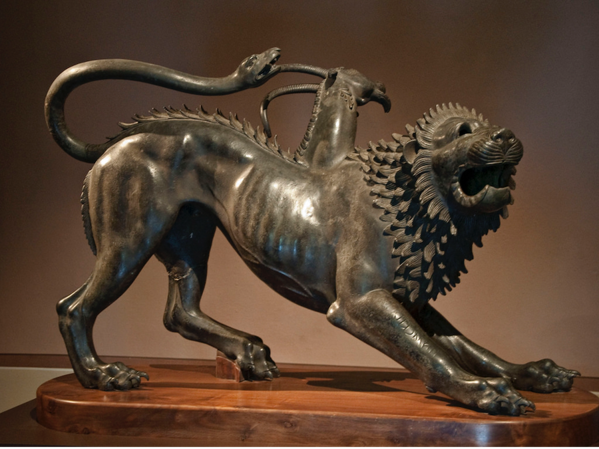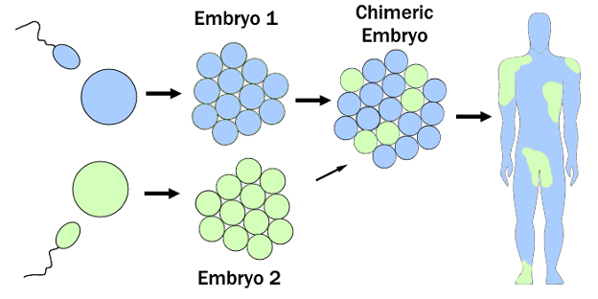
What are chimeras?
June 19, 2018

- Related Topics:
- Common questions,
- Chimera,
- Blood type,
- Rare events,
- Developmental biology
A curious adult from the US asks:
"What are chimeras?"
If you are familiar with Greek mythology, you may recall the story of the chimera. It was a beast with the heads of both a lion and a goat, and a serpent in the place of its tail.
The genetic meaning of “chimera” was inspired by this creature. A chimera is a person (or other plant or animal) who is made up of cells from two different individuals. Since those cells came from different sources, their DNA is also different.
Normally, your cells have your DNA, and only your DNA. This is one of the key rules of genetics. Your body is made up of many different kinds of cells, but they are all built using the same instruction manual. They all contain the exact same set of DNA.
But in chimeras, this rule is broken. Chimeras have two different sets of cells, with two different sets of DNA.
Which parts of you are chimeric might vary. For example, if you have blood chimerism, your blood cells will have a different set of DNA from the rest of you! But it does not mean your brain cells will also be chimeric. You might have only one set of brain cells, which would have only your DNA.
If you are a chimera, where do the cells with a different set of DNA come from? To find out, let’s take a closer look at how chimerism can happen in humans. We’ll keep using blood chimerism as an example.

Chimerism can save lives
Sometimes, chimerism is the result of a life-saving medical treatment. Perhaps you know someone who received an organ transplant. In their case, a healthy organ from a donor was used to replace their sick or damaged tissue.
Organ transplantation makes the recipient a chimera! The donated organ has cells from the donor, and they have the donor’s DNA. When the organ is transplanted into a patient, that doesn’t change. As a result, the patient will have two sets of cells. In most of their body, they’ll have their own cells, with their own DNA. But in the new organ, they’ll have the donor’s cells, with the donor’s DNA.
Bone marrow transplants are a common form of transplantation, where a patient’s bad bone marrow is replaced with healthy marrow from a donor. Bone marrow has the job of producing new red blood cells.
So if you get a marrow transplant, your blood will be made from the donated bone marrow. Since your blood is being made with someone else’s DNA, your blood type might change!

Chimeras can be completely natural
Some people become chimeras before they are even born! While you’re still just an embryo, you might pick up cells that aren’t yours. If your embryo absorbs the new cells, they can stay with you for the rest of your life.
One way for this to happen is if you have a twin. By chance, some of their cells may have ended up in you, or vice versa.
This can happen when cells pass from a baby through the placenta. Sometimes they end up in mom, and sometimes they end up in their sibling.

The tissues which become chimeric in this way vary. It depends on which cells pass through the placenta and where those cells end up.
However, blood chimerism is likely one of the more common results. The cells that form the marrow are tough and good at moving around. They are more likely to survive the trip through the placenta from one twin to the other.
As many as 8% of non-identical twins may have blood chimerism. For triplets, the chances of being a blood chimera are even higher, increasing to 21%.1
But what if you don’t have a twin? Can you still be a chimera? Actually, yes. Sometimes, chimerism is the result of something called vanishing twin syndrome.
Multiple embryos happen in about 5% of pregnancies.2 Usually, this leads to twins... but not always. About a quarter of the time, one of the embryos fails to go to term.2,3 If this happens, the embryo is sometimes reabsorbed into the mother. It might also fuse with its twin. An embryo which fuses this way becomes a chimera.

It is not clear how often chimeras are born this way. Based on the rates of multiple embryos and vanishing twin syndrome, as many as 1 in 80 people may be born from a vanishing twin pregnancy.
However, not all of these people will be chimeras. If the “vanished twin” reabsorbs into the mother, the baby that is born will not be a chimera. Since the two embryos did not fuse together, all of the baby's cells will have his or her own DNA.
Chimerism due to vanishing twin pregnancies may be getting more common. In vitro fertilization (IVF) leads to more pregnancies with multiple embryos. Vanishing twin syndrome is also more common in these pregnancies.4 As many as 1 in 10 people born by IVF may have had a vanished twin.5 But again, this does not necessarily mean they will all be chimeras.
Breaking the rules with chimerism
We have already seen how chimerism breaks the rule “your cells shall have your own DNA.” But chimerism can break other rules of genetics, too. Namely, the rules of inheritance.
Your children inherit half of your DNA, which is contained in your sperm or egg cells. Normally, the genes in these cells are contained in all the other cells in your body. But this may not be true for chimeras.
The genes in a chimera’s sperm or eggs may be different from the genes in the rest of their body. If so, the genes they pass to their children might not match our expectations. Their children could be born with traits that do not seem possible.
Let’s look back at blood type. Imagine that we have a chimera who received a bone marrow transplant. The person’s own DNA has the genes for type A blood, but their bone marrow donor had the genes for type B blood.
Chimerism can break genetic inheritance rules, and result in an “impossible” pattern of inheritance.
This person’s blood test will show type B blood, since it is made with the DNA from the donor. But their sperm or egg cells will be made from their own DNA, which has the genes for type A blood. This means they could pass on Type A blood to their children, even though they have Type B blood!
This is an outcome that looks impossible based on blood type. But chimerism makes it possible. The parent and the child’s blood types are being determined by DNA from two different people. In this way, chimerism can make almost any “impossible” pattern of inheritance possible.
It turns out that the rules of blood type can be broken in several other ways. Type O blood sometimes shows up where it is least expected, if one parent has the Bombay blood group. In other cases, a parent with AB blood can unexpectedly have AB or O type children, if they have the cis-AB allele.

Author: Robert Coukos
When this answer was published in 2018, Robert was a Ph.D. candidate in the Department of Genetics, studying protein engineering and directed evolution in Alice Ting’s laboratory. He wrote this answer while participating in the Stanford at The Tech program.
 Skip Navigation
Skip Navigation
